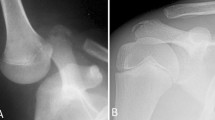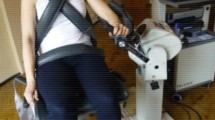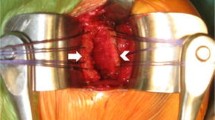Summary
Purpose: The purpose of this study was the evaluation of our results after posteroinferior capsular shift in patients with a posterior shoulder instability.
Materials and methods: In a prospective study we evaluated 12 patients (14 shoulder joints) with recurrent posterior shoulder dislocations who were stabilized by a posteroinferior capsular shift procedure. For the clinical documentation the Rowe-Score, the ASES-Score and the SF-36 were used. Furthermore the patients were submitted to standardized EMG-, isokinetic and proprioceptive tests.
Results: After an average follow-up of 22.2 months there were two recurrences which occurred during the first postoperative year. The Rowe-Score improved from 46.25 to 76.34 points. The ASES-Score showed an average of 42.43 points preoperatively and at the time of follow-up an average of 78.86 points. Most parameters of the ASES-Score as well as the score in total had a constant positive tendency. Only the subjective rating of stability showed a slight decrease after the first six months due to the two redislocations. But even the stable shoulder joints demonstrated limitations when throwing a ball. The SF-36 showed a definite gain in the overall quality of living as well.
The EMG-tests at follow-up showed a deficit for the patients compared with a control group; even more for the female than for the male patients. Similar tendencies were found with the isokinetic strength. The proprioception did not show any differences between the patients and the control group.
Conclusion: With adequate patient selection and after failure of all possible conservative treatments the posteroinferior capsular shift is a therapeutical option in recurrent posterior shoulder instability.
Zusammenfassung
Ziel der vorliegenden Untersuchung ist die Darstellung der eigenen Ergebnisse nach postinferiorem Kapselshift bei Patienten mit dorsalen Schulterinstabilitäten. In einer prospektiven Untersuchung wurde bei 12 Patienten (14 Schultergelenke) mit dorsal rezidivierender Schulterluxation ein posteroinferiorer Kapselshift durchgeführt. Für die klinische Dokumentation wurden der Rowe- und der ASES-Score (American Shoulder and Elbow-Score) sowie der SF-36 verwendet. Zusätzlich erfolgten standardisierte EMG-, isokinetische und Propriozeptionsuntersuchungen. Nach einem mittleren Nachuntersuchungszeitraum von 22,2 Monaten zeigten sich 2 Rezidive, die alle innerhalb des ersten postoperativen Jahres auftraten. Der Rowe-Score stieg von 46,25 Punkte auf 76,34 Punkte zum Zeitpunkt der Nachuntersuchung. Der ASES-Score betrug präoperativ 42,43 Punkte und erreichte zum Zeitpunkt der Nachuntersuchung 78,86 Punkte. Hierbei zeigten die meisten Parameter des ASES-Scores eine gleichbleibend positive Tendenz wie der Gesamtscore. Lediglich bei der subjektiven Stabilitätsbewertung kam es aufgrund der beiden Rezidive zu einer leichten Verschlechterung nach den ersten 6 Monaten. Es fand sich jedoch auch bei den stabilen Schultergelenken nach wie vor eine Einschränkung beim Werfen eines Balles. Der SF-36 zeigte einen Zugewinn der allgemeinen Lebensqualität. Die EMG-Untersuchung zum Zeitpunkt der Nachuntersuchung ergab deutliche Defizite im Vergleich zu einem Kontrollkollektiv, die bei den weiblichen Patientinnen ausgeprägter waren als bei den männlichen. Ähnliche Tendenzen fanden sich bei isokinetischen Kraftmessungen zum Zeitpunkt der Nachuntersuchung. Die Propriozeptionsmessungen ergaben keinen Unterschied der Patienten im Vergleich zu einem Normalkollektiv. Bei adäquater Patientenselektion und nach Ausschöpfung aller konservativen therapeutischen Möglichkeiten ist der posteroinferiore Kapselshift eine therapeutische Option bei rezidivierender dorsaler Schulterinstabilität.
Similar content being viewed by others
Author information
Authors and Affiliations
Rights and permissions
About this article
Cite this article
Jerosch, J., Steinbeck, J. & Schaphorn, G. Results of posteroinferior capsular shift in patients with posterior shoulder instability. Unfallchirurg 101, 755–761 (1998). https://doi.org/10.1007/s001130050334
Published:
Issue Date:
DOI: https://doi.org/10.1007/s001130050334




